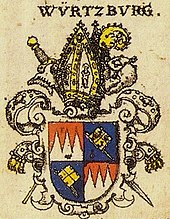List of the bishops of Würzburg
The list of the bishops of Würzburg contains the chronological order of the bishops since the foundation of the diocese of Würzburg from 742 until today.
From 1168 to 1803 the bishops also carried the title of Duke of Franconia . This was first and foremost an attempt by the Staufer to follow the Salian tradition . However, the politically hoped-for breakthrough into a large state was refused, so that the title was given a more symbolic meaning. The Würzburg bishopric tried in phases to gain a position of supremacy in today's Franconian area over the margraves of Brandenburg-Kulmbach or Brandenburg-Bayreuth and the Bamberg bishopric . With the secularization of the bishopric, Würzburg fell to Bavaria in 1802 and - after the interlude of the Grand Duchy of Würzburg (1806–1814) - again in 1814. Ecclesiastically, the Diocese of Würzburg has been subordinate to the Archdiocese of Bamberg as a suffragan diocese since 1818 .
For a long time the bishops came from Franconian noble families (see also list of Franconian knight families ). Some bishops were first canons at Würzburg Cathedral (see also list of Würzburg canons ), and some of them were also employed in other dioceses, particularly often in personal union with the diocese and bishopric of Bamberg . A series of portraits of bishops was made by the engraver Johann Salver at the beginning of the 18th century , these are shown in the list in the absence of contemporary images - despite the associated problems - with the early bishops. Other important figures in the diocese's religious life are the auxiliary bishops in Würzburg .
The coat of arms of the diocese is quartered . In Siebmacher 1605 it shows the Franconian rake in fields 1 and 4 symbolically for the Duchy of Franconia and in fields 2 and 3 for the diocese of Würzburg a slanted golden flag on a blue background. The coats of arms of the individual bishops usually bring their own family coat of arms into the crossing. If the prince-bishop's coat of arms is not available as a picture, the family coat of arms is partially shown in the list. The coats of arms come from the early part of Scheibler's coat of arms book from the middle of the 15th century and from Siebmacher's coat of arms book from 1605. The Würzburg University Library has a chronicle of the bishops of Würzburg (real copy), written by Lorenz Fries from 1574 to 1582. From some coats of arms were also taken from the attached list of bishops.
List of the bishops of Würzburg
| No. | bishop | from | to | description | presentation | coat of arms |
|---|---|---|---|---|---|---|
| 1 | St. Burkard | 742 | 754 | Burkard was a monk from southwest England and previously abbot of the Neustadt am Main monastery. He was engaged in the Gentile mission. Burkard died in February 755 in Homburg am Main. | ||
| 2 | St. Megingaud | 754 | 769 | Meginaud was previously abbot at Neustadt Abbey. As bishop he represented his diocese at various imperial assemblies and synods. He resigned his office and retired to his former monastery in Neustadt am Main, where he died in 783. | ||
| 3 | Berowelf | 769 | 794 | Berowelf worked beyond the diocese borders in the missionary work in Slavic areas and is named there as the founder of the church. | ||
| St. Gumbert | 794 | 795 | Gumbert is the founder and first abbot of the St. Gumbertus Monastery . He left several relics . He died while being elected bishop. |
 Copper engraving by St. Gumbert |
||
| 4th | Liutrit | 795 | 802 | Liutrit continued the Slavic missionary activity of his predecessors. The founding of monasteries and related donations put a strain on the diocese. | ||
| 5 | Egilwart | 802 | 809 | Egilwart took up the missionary work. Further monasteries were founded. | ||
| 6th | Wolfgar | 809 | 831 | Relations with the Fulda monastery improved under Wolfgar . | ||
| 7th | Hunbert | 832 | 842 | Hunbert hardly made an appearance in imperial politics; he devoted his energies to the continuous expansion of the cathedral library. | ||
| 8th | Gozbald | 842 | 855 | Gozbald was proposed as bishop by Ludwig II the German ; from 830 to 833 he was head of the royal chancellery. | ||
| 9 | Arn | 855 | 892 | The rebuilding of the burned down cathedral began under Arn. He took an active part in the Reichstag and Reich synods. On the way back from a campaign against the Bohemians, he was killed together with his companions by Slavic troops north of the Ore Mountains in 892. | ||
| 10 | Rudolf I. | 892 | 908 | Rudolf was a Conradin . He fell fighting the Hungarians. | ||
| 11 | Thioto | 908 | 931 | Thioto is only detectable in imperial politics; he did not leave any traces in Würzburg. | ||
| 12 | Burchard II | 932 | 941 | Abbot of the Hersfeld Abbey | ||
| 13 | Poppo I. | 941 | 961 | Poppo came from the Babenberg family with powerful brothers. He was favored by the king as a candidate for the office of bishop and also became its chancellor. | ||
| 14th | Poppo II. | 961 | 983 | |||
| 15th | Hugo | 983 | 990 | Hugo was committed to the reactivation of monasteries that had fallen in the 10th century. He devoted himself particularly to the St. Andrew's monastery , to which he assigned the new patron saint Burkhard , whose bones were transferred to the monastery. The current Burkhard monastery received parishes and villages that were supposed to secure the economic situation. | ||
| 16 | Bernward | 990 | 995 | Bernward also continued the revitalization of monasteries. One felt empowered to subsequently draw up documents from past kings in order to tie in with past rights. | ||
| 17th | Heinrich I. | 996 | 1018 | The Bishopric of Bamberg was founded during the time of Bishop Heinrich . This meant a relocation of territory for the diocese of Würzburg, which also grew in size continuously. The city wall of Würzburg was laid out. Heinrich fought with the king against the margrave Heinrich von Schweinfurt . | ||
| 18th | Meginhard I. | 1018 | 1034 | Meginhard was busy with disputes between the Bishop of Mainz Aribo and the Pope regarding the marriage matters of Countess Irmgard von Hammerstein and the Gandersheim church dispute . | ||
| 19th | St. Bruno | 1034 | 1045 | Bruno had the Würzburg Cathedral rebuilt. Bruno died in an accident at a feast in connection with the regulation of the inheritance of the late Count Adalbero II von Ebersberg . | ||
| 20th | St. Adalbero | 1045 | 1090 | In the investiture controversy , Adalbero was a staunch supporter of Pope Gregory VII. Driven into exile because of his convictions, he spent his last years in the Lambach monastery while opposing bishops were in office in Würzburg. The miracles handed down after his death finally led to his canonization in 1883. The picture shows Adalbero as a plastic figure on his epitaph. |
 Epitaph of the bishop |
|
| Meginhard II | 1085 | 1088 | Meinhard was appointed bishop by Henry IV after Adalberus was expelled . Already after his return from the corridor to Canossa in 1077 or 1078 he had appointed the Naumburg bishop Eberhard as administrator of Würzburg. Eberhard died in 1079 near Würzburg when he fell from his horse. | |||
| 21st | Emehard | 1089 | 1105 | He was the firstborn son of Count Richard von Comburg and was appointed bishop by Heinrich IV. | ||
| 22nd | Erlung | 1105 | 1121 | He was appointed by King Henry IV and later confirmed by his son and successor. | ||
| Rupert | 1105 | 1106 | Rupert was appointed bishop by Heinrich V , who fought over the crown with his father Heinrich IV. After Heinrich V had decided the dispute for himself, he confirmed the Erlung appointed by his father. | |||
| 23 | Rugger | 1121 | 1125 | Elected bishop in Münsterschwarzach by the anti-imperial party under the leadership of Adalbert I of Saarbrücken , Archbishop of Mainz | ||
| Gebhard von Henneberg | 1121 | 1127 | Elected bishop by the imperial party, he was unable to assert himself even after Rugger's death and gave up his claim in 1127. In 1125 Ulrich von Bamberg dedicated the work Codex Udalrici to him . | |||
| 24 | Embricho | 1127 | 1146 | Embricho founded several monasteries, including the Schottenkloster Würzburg , Wechterswinkel monastery and Oberzell monastery of the Premonstratensians . He died on the way back as the diplomatic envoy of Konrad III. in Aquileia , where he was also buried. | ||
| 25th | Siegfried von Truhendingen | 1146 | 1150 | Siegfried came from the old, noble Franconian-Swabian counts of the von Truhendingen family . | ||
| 26th | Gebhard von Henneberg | 1150 | 1159 | Gebhard was elected bishop a second time and was now able to prevail. He was committed to the election of Friedrich Barbarossa and was in close contact with him, which brought Würzburg an imperial court assembly and a Reichstag. | ||
| 27 | Heinrich II of Stühlingen | 1159 | 1165 | The diocese made considerable efforts to finance the contingents for Friedrich Barbarossa's campaigns. Royal documents legitimizing the claim to the ducal office in Franconia were forged. During this time Johannes von Würzburg also appeared. | ||
| 28 | Herald of Höchheim | 1165 | 1171 | At the Reichstag in Würzburg on July 10, 1168 the Güldene Freiheit was issued. The document was written by Wortwin . Friedrich Barbarossa certified the Würzburg bishop the ducal dignity. The bishop was given extensive rights over jurisdiction, but by no means the hoped-for supremacy of the old tribal duchy. | ||
| 29 | Reginhard von Abenberg | 1171 | 1186 | Reginhard came from the noble family of Counts von Abenberg . Even if he was hardly involved in imperial politics, he was directly involved in the overthrow of Henry the Lion . | ||
| 30th | Gottfried I. von Spitzenberg | 1186 | 1190 | Gottfried gave up his office as Bishop of Regensburg (1185–1186) in favor of Würzburg. He organized a crusade to recapture the recently lost Jerusalem. Like many other crusaders, he died of a plague-like disease in Antioch . |
 Epitaph of the bishop |
|
| Philip of Swabia | 1190 | 1191 | Philipp, a son of Emperor Friedrich Barbarossa, was Elekt , but resigned the office in 1191, after his resignation from the clergy he was Duke of Swabia (1196-1208), Margrave of Tuscany (1195-1197) and Roman until his murder -German King (1198–1208) from the House of Staufer . He left no traces in Würzburg. The picture shows Philip as a miniature painting in a manuscript around 1200. |
 Miniature painting around 1200 |
||
| 31 | Henry III. from mountain | 1191 | 1197 | Heinrich was bishop of Passau from 1169 to 1172 , later cathedral provost in Speyer and Bamberg, elected bishop of Würzburg in 1191, consecrated in 1192 by Archbishop Konrad of Mainz. In the imperial politics he appeared in 1193 as the emperor Heinrich VI. was a guest in Würzburg and negotiated a treaty with Duke Leopold of Austria on February 14 for the extradition of the English King Richard the Lionheart , who had been captured on his return from the Third Crusade . |
 Family coat of arms |
|
| 32 | Gottfried II. | 1197 | 1197 | Gottfried died immediately after his election. |
 Family coat of arms |
|
| 33 | Conrad I of Querfurt | 1198 | 1202 | Konrad swapped his position as Bishop of Hildesheim (1194–1199) in favor of Würzburg and thus paved the way for the Würzburg bishopric for his Lobdeburg relatives. He fell victim to an intrigue and was murdered by Bodo von Ravensburger. The oldest surviving part of today's Marienberg Fortress, the prince's building , also goes back to him. | ||
| 34 | Heinrich IV of Heßberg | 1202 | 1207 | Heinrich, nicknamed "Caseus", came from the von Heßberg family . |
 Family coat of arms after Siebmacher |
|
| 35 | Otto I of Lobdeburg | 1207 | 1223 | Otto led a representative life, which brought the financial budget of the diocese into trouble. His merits lie in imperial politics. In 1212 he sat down against the later Eichstätter Bishop Heinrich III. from Ravensburg , who, with the support of the Mainz Metropolitan, contested the bishop's seat for him. | ||
| 36 | Dietrich von Homburg | 1223 | 1225 | |||
| 37 | Hermann I of Lobdeburg | 1225 | 1254 | Through clever policy, Hermann succeeded in expanding the area of the diocese, reorganizing the budget and asserting himself against claims by neighboring princes. He was the founder of various monasteries. | ||
| Heinrich V of Leiningen | 1254 | 1255 | Heinrich occupied Würzburg because of a papal expectance, which was horrified in 1255. After an arbitration, he renounced his claims in Würzburg and died on January 18, 1272 as Bishop of Speyer . |
 Family coat of arms |
||
| 38 | Iring von Reinstein-Homburg | 1254 | 1265 | In the dispute over the bishop's chair, Iring put a lot of energy into the dispute with Heinrich von Leiningen . He had the support of the citizens of Würzburg. As a bishop, he maintained peaceful relations with his neighbors and devoted himself to church affairs. |
 Family coat of arms after Siebmacher |
|
|
Sedis vacancy Otto von Lobdeburg |
1265 | 1267 | Otto, a Lobdeburger , was Chapter Vicar during the Sedis vacancy. | |||
| 39 | Poppo III. from Trimberg | 1267 | 1271 | As the elected bishop, Poppo had to assert himself against Berthold I. von Henneberg . He died after a few years as a bishop during which he asserted his claim in trials at the curia . | ||
| Berthold I. von Henneberg | 1267 | 1274 | Berthold had hardly had the dispute with Poppo III as a counter-bishop . von Trimberg survived, his future successor Berthold II. von Sternberg challenged his position. Both met with their armies at the Battle of Kitzingen in 1266. Berthold had to give up permanently and he was resigned in 1275. He died on December 29, 1312 as Auxiliary Bishop of Mainz . |
 Family coat of arms after Scheibler |
||
| 40 | Berthold II von Sternberg | 1274 | 1287 | In the fight for the bishop's chair, Berthold defeated Berthold I. von Henneberg in the battle of Kitzingen. Both ultimately agreed in a settlement. According to an Ebrach tradition, however, he is the first bishop to have his heart buried in the Ebrach monastery . This is also indicated by a sepulture there behind the high altar from the early 14th century. |
 Family coat of arms |
|
| 41 | Manegold of Neuchâtel | 1287 | 1303 | Mangeold was Bishop of Bamberg (1285–1286), he gave up this position and moved to Würzburg. |

|
|
| 42 | Andreas von Gundelfingen | 1303 | 1313 | Andreas supported King Albrecht I in the campaign against Bohemia. Disputes arose with the Counts of Henneberg because of the double pledging of the castle and town of Schweinfurt . |
 Family coat of arms |
|
|
Sedis vacancy Friedrich von Stolberg |
1313 | 1314 | The Canon Friedrich was apparently after the election of Gottfried III. von Hohenlohe elected bishop by a minority and favored by Ludwig the Bavarian . He died at the curia. It was not until 1317 that all parties agreed on Gottfried III. |
 Family coat of arms |
||
| 43 | Gottfried III. from Hohenlohe | 1314 | 1322 | In the dispute over the throne between Ludwig IV and Friedrich III. Gottfried sided with Friedrich III, as did the House of Hohenlohe and the Franconian nobility as a whole. |
 Detail from the epitaph of the bishop |
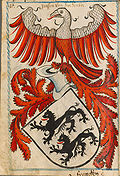 Family coat of arms after Scheibler |
| 44 | Wolfram Wolfskeel from Grumbach | 1322 | 1333 | Wolfram was one of the few imperial princes on the side of Pope John XXII. against Ludwig the Bavarian . He later reconciled with the king, but he also managed to maintain good relations with the Pope. |
 Detail from the epitaph of the bishop |
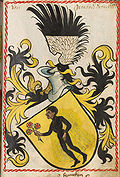 Family coat of arms after Scheibler |
| 45 | Hermann II. Hummel von Lichtenberg | 1333 | 1335 | Hermann was Chancellor of Emperor Ludwig the Bavarian and in 1333 there was a double election together with Otto II von Wolfskeel . He asserted himself as counter-bishop in Würzburg until his death, but was then replaced by Otto II. |
 Family coat of arms |
|
| 46 | Otto II von Wolfskeel | 1333 | 1345 | Otto II achieved significant territorial expansions of the diocese. His term of office was also successful in a spiritual sense: he was able to establish 13 new parishes, reformed some monasteries and introduced the office of vicar general. |
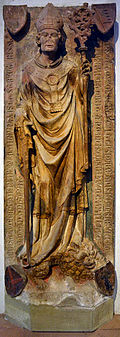 Epitaph of the bishop |
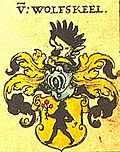 Family coat of arms after Siebmacher |
| 47 | Albrecht I of Hohenberg | 1345 | 1349 | Albrecht († 1359) tried to get his home diocese as Bishop of Constance . Immediately after his time in Würzburg he was Bishop of Freising (1349–1359). |
 Detail from the epitaph of the bishop |
 Family coat of arms after Scheibler |
| 48 | Albrecht II of Hohenlohe | 1345 | 1372 | Albrecht was also elected in 1345, and in 1350 he actually took his place as bishop. Despite a comprehensive Franconian peace , Albrecht allied himself with the neighboring princes to smash the Schlüsselberger property. Konrad II von Schlüsselberg died as the last of his line during the siege. |
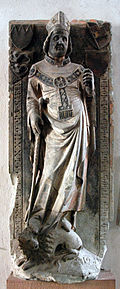 Epitaph of the bishop |
 Family coat of arms after Scheibler |
| Withego Hildbrandi | 1372 | 1372 | Withego and Albrecht III. von Hessberg were chosen at the same time. While Withego transferred as Bishop of Naumburg , Albrecht defended his claims as counter-bishop . | |||
| Albrecht III. from Heßberg | 1372 | 1376 | Albrecht and Withego Hildbrandi were chosen at the same time. Pope Gregory XI. defied the decision of the cathedral chapter and handed over the Würzburg bishop's seat to Gerhard von Schwarzburg . While Withego transferred as Bishop of Naumburg , Albrecht defended his claims as counter-bishop . It was only when Gerhard came with an army that he fled to his possessions and only came to terms with Gerhard years later. He then worked again as the Würzburg canon . |
 Family coat of arms after Siebmacher |
||
| 49 | Gerhard von Schwarzburg | 1372 | 1400 | As a beleaguered Bishop of Naumburg (1359-1372), Gerhard moved to Würzburg. During his reign, Würzburg and other cities of the bishopric rebelled, but were overthrown. Internal conflict ruled the era. |
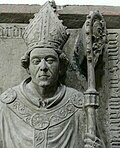 Detail from the epitaph of the bishop |
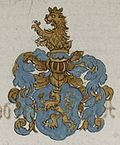 Family coat of arms |
| 50 | Johann I of Egloffstein | 1400 | 1411 | Johann was involved in the Franconian city war in 1397 as a leader in the decisive battle of Bergtheim . As the brother of Konrad von Egloffstein , he also appeared after the defeat of the Teutonic Order in the Battle of Tannenberg in Prussia and took part in the peace negotiations between the Order and Poland. Together with his brother, he is in Thorn among the authorized representatives of the Teutonic Order who signed the First Peace of Thorn . |
 Detail from the epitaph of the bishop |
 Family coat of arms after Scheibler |
| 51 | Johann II of Brunn | 1411 | 1440 | Under Johann the burden of debts of the monastery increased, the cathedral chapter tried to replace him with co-adjutors. He was involved in measures against the Hussites invading the empire . |
 Detail from the epitaph of the bishop |
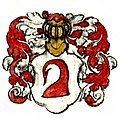 Family coat of arms |
| 52 | Sigismund of Saxony | 1440 | 1443 | The expected bearer of hope, Sigismund, brings a new set of problems into the diocese: In the expectation of the Saxon electoral family to expand their influence on the diocese of Würzburg, Sigismund behaved very unusual and allied himself with the margrave Albrecht Achilles to assert his interests . The increasing domestic and foreign political pressure finally forced him to abdicate. He died in exile on December 24, 1471. He was buried in the princely crypt of the Meissen Cathedral . |
 Epitaph of the bishop |
 Family coat of arms |
| 53 | Gottfried IV Schenk of Limpurg | 1443 | 1455 | Gottfried began to consolidate the state budget and led the diocese relatively unscathed through times of war. |
 Detail from the epitaph of the bishop |
 Family coat of arms |
| 54 | Johann III. from Grumbach | 1455 | 1466 | Johann stood for the ceremonial sword instead of the crook . He took a counterpoint to his predecessor and got involved in numerous feuds and conflicts with the neighboring principalities. |
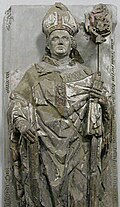 Detail from the epitaph of the bishop |
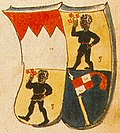 Episcopal coat of arms in the Ingeram Codex |
| 55 | Rudolf II of Scherenberg | 1466 | 1495 | Rudolf was considered a prudent administrator who paid off debts and pledged property and offices or gained them. He prevailed over Hans Böhm , a shepherd who, as a penitential preacher, apparently addressed thousands of farmers who made pilgrimages to him in Niklashausen . Hans Böhm ended up at the stake , the huge crowd broke up again relatively peacefully. The epitaph of the bishop created by Tilman Riemenschneider shows him with detailed (not idealized) facial features and the posture of an old man. |
 Detail from the epitaph of the bishop |
 Family coat of arms |
| 56 | Lorenz von Bibra | 1495 | 1519 | Lorenz was in contact with important people of his time, including Martin Luther and Johannes Trithemius . In contrast to his predecessor, his epitaph from the hand of Tilman Riemenschneider shows him in the late Gothic, idealized style. |
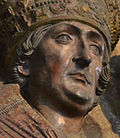 Detail from the epitaph of the bishop |
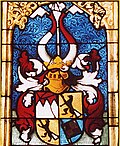 Increased coat of arms of the Prince-Bishop as a church window of the Church of St. Leo in Bibra |
| 57 | Konrad II of Thüngen | 1519 | 1540 | The Peasants' War raged at times almost Conrad focus within the limits of the diocese. Only with the help of the Swabian Federation did the bishop, who had fled, succeed in recapturing Würzburg . During the Franconian War he campaigned for his beleaguered relatives on the Reußenburg . Lorenz Fries was one of his advisory staff, who also stood by his two successors and is known today for his chronicles. The picture shows the bishop as an engraving by Johann Octavian Salver (1670–1738). |
 18th century engraving by Johann Salver |
 Family coat of arms after Scheibler |
| 58 | Conrad III. from Bibra | 1540 | 1544 | Konrad was in a conflict with his spiritual dignity, he tried several times to give up his ordination. |
 Painting of the bishop |
 Family coat of arms after Siebmacher |
| 59 | Melchior Zobel from Giebelstadt | 1544 | 1558 | Melchior fell victim to the feud with Wilhelm von Grumbach , who later made a name for himself in Grumbach's Handel . |
 Medal with the portrait of the bishop (medalist: Joachim Deschler ) |
 Family coat of arms after Siebmacher |
| 60 | Friedrich von Wirsberg | 1558 | 1573 | Friedrich initially pursued his predecessor's murderers in the direction of France. |
 Detail from the epitaph of the bishop |
 Prince-Bishop's coat of arms on a coin from 1569 family coat of arms after Scheibler 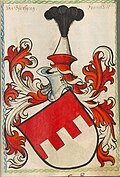 |
| 61 | Julius Echter von Mespelbrunn | 1573 | 1617 | Julius vigorously pursued the Counter Reformation . He built numerous churches. In the Fuldaian Handel , Balthasar von Dernbach was deposed and he took over the role of administrator of the abbey of Fulda , much to the displeasure of Pope Gregory XIII. Witch trials in Würzburg increased significantly under him in the diocese. The picture shows the bishop in a painting from 1586. |
 contemporary painting of the bishop from 1586 |
 Episcopal coat of arms in the vaulted ceiling of the church in Aub |
| 62 | Johann Gottfried von Aschhausen | 1617 | 1622 | Johann Gottfried, who was also Prince-Bishop of Bamberg (1609–1622), went down in history as a witch hunter. The persecution took on dramatic proportions during his reign. |
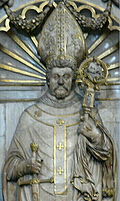 Detail from the epitaph of the bishop |
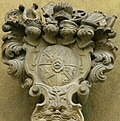 Episcopal coat of arms in Würzburg Family coat of arms after Siebmacher  |
| 63 | Philipp Adolf von Ehrenberg | 1623 | 1631 | The witch trials were continued under Philipp Adolf. It also stands for a relentless course of recatholization . |
 Philipp Adolf von Ehrenberg |
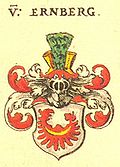 Family coat of arms after Siebmacher |
| 64 | Franz von Hatzfeld | 1631 | 1642 | Franz was also Prince-Bishop of Bamberg (1633–1642). During the Thirty Years' War the Swedes occupied Bamberg, Franz was forced to flee to Cologne . The Swedish Chancellor Axel Oxenstierna enfeoffed Duke Bernhard of Saxe-Weimar with the dioceses of Würzburg and Bamberg in 1633 . The two dioceses were to be merged permanently under the name "Duchy of Franconia". After the defeat at Nördlingen , the Swedes could no longer hold out and Franz returned from exile in 1634. |
 Franz von Hatzfeld |
 Family coat of arms |
| 65 | Johann Philipp von Schönborn | 1642 | 1673 | During the Thirty Years' War he negotiated relief for the signed diocese from the various warring parties. Due to his prudent role in the negotiations for the Peace of Westphalia , he also became Archbishop of Mainz (1647–1673) and later Bishop of Worms (1663–1673). He was one of the first princes to ban witch trials on his territory. He was also tolerant of Protestantism and took care of converts . The picture shows a representation in a coronation diary from 1658. |
 contemporary print from 1658 |
 Family coat of arms |
| 66 | Johann Hartmann von Rosenbach | 1673 | 1675 | Johann Hartmann was only in office for a few years. During his tenure, the French invaded the diocese in the Dutch War under Henri de La Tour d'Auvergne, vicomte de Turenne , but were repulsed by Raimondo Montecuccoli . |
 contemporary painting of the bishop |
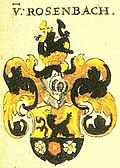 Family coat of arms after Siebmacher |
| 67 | Peter Philipp von Dernbach called Graul | 1675 | 1683 | With the support of the Pope and Emperor, Peter Philipp was also Prince-Bishop of Bamberg (1672–1683). He succeeded in converting the Wiesentheid rule into an imperial county and subordinating it to his nephew. |
 contemporary painting of the bishop |
 Coat of arms of the Prince-Bishop of Bamberg (1672–1683) and Prince-Bishop of Würzburg (1674–1683) |
| 68 | Konrad Wilhelm von Wernau | 1683 | 1684 | Konrad Wilhelm was only briefly in office. He died before his papal confirmation. The picture shows the bishop as an engraving by Johann Salver (1670–1738). |
 18th century engraving by Johann Salver |
 Family coat of arms after Scheibler |
| 69 | Johann Gottfried von Guttenberg | 1684 | 1698 | In the Palatinate War (1688–1697) the bishop left the military association of the Franconian Empire and entered into an alliance with the emperor, to which he also subordinated troops. He was the founder of the brotherhood "Maria Hilf" and developed a brisk construction activity. |
 Contemporary engraving |
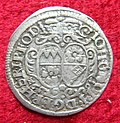 The reverse of the coin shows the episcopal coat of arms |
| 70 | Johann Philipp von Greiffenclau zu Vollraths | 1699 | 1719 | Johann Philipp stands for further construction activities in Würzburg. |
 Johann Philipp von Greiffenclau Vollraths |
 Family coat of arms after Siebmacher |
| 71 | Johann Philipp Franz von Schönborn | 1719 | 1724 | Johann Philipp Franz came from the influential von Schönborn family . He was the nephew of Lothar Franz von Schönborn and three of his brothers also became bishops, including the later Bishop of Würzburg, Johann Philipp Franz von Schönborn . Johann Philipp Franz was extremely unpopular among the population. He laid the foundation stone for the Schönborn Chapel , begun in 1721 , designed by Johann Balthasar Neumann and intended as the family's burial place. |
 Painting of the bishop |
 Family coat of arms |
| 72 | Christoph Franz von Hutten | 1724 | 1729 | Compared to the alternative candidate Friedrich Karl von Schönborn-Buchheim with absolutist features, Christoph Franz was considered close to the people, because he came from a knightly family and promoted the veneration of Mary . But he also carried out major building projects associated with the name of Johann Balthasar Neumanns . This required tax increases and he used the instruments of mercantilism . |
 Detail from the epitaph of the bishop |
 Family coat of arms after Siebmacher |
| 73 | Friedrich Karl von Schönborn-Buchheim | 1729 | 1746 | Friedrich Karl succeeded his uncle Lothar Franz von Schönborn as Prince-Bishop of Bamberg (1729–1746) and took over the office in Würzburg a little later. Friedrich Karl was active as a builder and patron to an unprecedented extent . With this he set economic and artistic impulses. Reforms and its promotion of the sciences were enlightened . |
 Painting of the bishop |
 Family coat of arms |
| 74 | Anselm Franz von Ingelheim | 1746 | 1749 | Anselm Franz was only in office for a short time. He tried to differentiate himself from the era of the Schönborn family, which had set numerous accents. |
 Painting of the bishop |
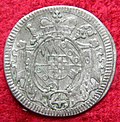 The reverse of the coin from 1748 shows the episcopal coat of arms |
| 75 | Karl Philipp von Greiffenclau on Vollrads | 1749 | 1754 | Karl Philipp is the nephew of the former Würzburg bishop Johann Philipp von Greiffenclau zu Vollrads . He continued the patronage of the Schönborn family as a patron of the sciences and through numerous construction activities, where he employed well-known artists. In addition to long- serving Johann Balthasar Neumann , he gave orders to Johann Zick , Antonio Giuseppe Bossi and Giovanni Battista Tiepolo . In 1749, the last witch in the diocese was burned as a single event. The picture shows Karl Philipp as a ceiling painting portrait by Giovanni Battista Tiepolo in the Würzburg Residence . |
 Depiction of the bishop in a ceiling painting |
 Family coat of arms after Siebmacher |
| 76 | Adam Friedrich von Seinsheim | 1755 | 1779 | A little later, Adam Friedrich was also Prince-Bishop of Bamberg (1757–1779). In the Seven Years' War he entered into an alliance with Austria, which led to the Prussians invading the bishopric. Economically, he took care of inland shipping, e.g. B. the construction of the old crane and the establishment of factories . He introduced compulsory schooling in 1762. He completed the construction of the fourteen saints basilica . The picture shows him on a convention thaler from 1764. |
 contemporary painting |
 Episcopal coat of arms in Bamberg portrait and episcopal coat of arms on a convention thaler from 1764 
|
| 77 | Franz Ludwig von Erthal | 1779 | 1795 | Franz Ludwig was at the same time Prince-Bishop of Bamberg , (1779–1795). He was an enlightening bishop who had Bamberg's first modern hospital built and who introduced the first public social insurance. The university was expanded to include a chair in veterinary medicine. The picture shows his portrait on the front of a 20 Kreuzer coin from 1785. |
 Coin from 1785 with a portrait of the bishop |
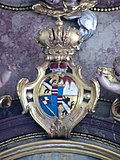 Episcopal coat of arms in Absberg |
| 78 | Georg Karl von Fechenbach | 1795 | 1808 | Georg Karl was the last Würzburg prince-bishop to face secularization in 1802 . In the Treaty of Lunéville it was decided to abolish the clerical principalities, and a little later Bavarian troops marched into the bishopric. Georg Karl defended his spiritual powers as bishop and at the same time succeeded his uncle Christoph Franz von Buseck as coadjutor in Bamberg (1805-1808). After the Peace of Pressburg , the former Bishopric went as a Grand Duchy of Ferdinand, the former Grand Duke of Tuscany over. Until it fell back to Bavaria, the director of the newly established vicariate, Auxiliary Bishop Gregor Zirkel , managed to wrest concessions from the Grand Duke. |
 Detail from the epitaph of the bishop |
 Episcopal coat of arms |
|
Sedis vacancy Johann Franz Schenk von Stauffenberg |
1808 | 1818 | After the death of Georg Karl von Fechenbach , the usual election of a new bishop by a cathedral chapter was no longer provided. Therefore Pope Pius VII. Johann Franz Schenk appointed Baron von Stauffenberg as vicar of the capitular . | |||
| No. | Suffragan bishop | from | to | description | portrait | coat of arms |
| 79 | Friedrich Groß zu Trockau | 1818 | 1840 | Adam Friedrich Freiherr von Groß zu Trockau was initially Apostolic Vicar of Bamberg (1812-1818) until he prevailed against several candidates in an election that was extremely tense because of the secularization. He went to great lengths to reorganize the diocese, with particular attention to strengthening the seminary. |
 Detail from the epitaph of the bishop |
 Family coat of arms after Siebmacher |
| 80 | Georg Anton von Stahl | 1840 | 1870 | Georg Anton was the first civil bishop of Würzburg. Like his successors until 1924, he is also listed as a staff nobility with a “von” in his name . During his tenure in office, the Caritas associations were formed in the Würzburg area : Hardly any Catholic family was not organized in a Christian association. In 1848 the first German Bishops' Conference took place in Würzburg . At the First Vatican Council he diplomatically refused to sign the infallibility dogma that was supposed to fuel the Kulturkampf in Germany . He died shortly afterwards at the council. |
 View from 1848 detail from the epitaph of the bishop  |
 Coat of arms on the facade of the Bonifatius Chapel on the Salzburg b. Bad Neustadt ad Saale |
| 81 | Johann Valentin von Reissmann | 1870 | 1875 | Johann Valentin's term of office was dominated by the Kulturkampf . Even if Bavaria was not directly affected, the Würzburg seminary accepted clergymen from other dioceses, including the later Cardinal Adolf Bertram . |
 Detail from the epitaph of the bishop |
|
| Sedis vacancy Ambrosius Käß |
1876 | 1878 | Without consulting the curia, King Ludwig II appointed the prior of the Würzburg Carmelite Monastery, Ambrosius, to succeed the late Bishop Johann Valentin von Reissmann . After this was aware that Pope Leo XIII. would not accept his appointment, he asked the king to withdraw his appointment. | |||
| 82 | Franz Joseph von Stein | 1878 | 1898 | King Ludwig II decided again without consulting the Curia Franz Joseph. Franz Joseph was then also Archbishop of Munich and Freising (1897–1909). |
 Photograph of the bishop |
 Episcopal coat of arms |
| 83 | Ferdinand von Schlör | 1898 | 1924 | Starting from the Catholic enclave Wolfmannshausen , which was looked after by the diocese of Würzburg and was the only supervised parish to belong to Saxony-Meiningen , the Catholic community had expanded further in neighboring Meiningen and Hildburghausen . The other neighboring Bamberg and Paderborn also did development work here, so that the existing curates were elevated to parishes and an episcopal commissariat was formed in Meiningen . He supported Herman Schell, who was uncomfortable for his time . |
 Photograph of the bishop |
 Episcopal coat of arms |
| 84 | Matthias Ehrenfried | 1924 | 1948 | Matthias Ehrenfried became known as the "Resistance Bishop" against the National Socialists . Immediately after the seizure of power , tensions began between the church and the National Socialists. While the bishop publicly defended his position and tried to protect his priests, the totalitarian state apparatus increased its pressure. In 1941 the abbey Münsterschwarzach was closed with the monastery tower . Many priests, because of their beliefs, are a. died in Dachau concentration camp . |
 Photograph of the bishop |
 Episcopal coat of arms |
| 85 | Julius Döpfner | 1948 | 1957 | Julius Döpfner's tenure began in a completely destroyed city in which only about 6,000 people lived at the end of the war. Destroyed churches were initially repaired for the first church services. The restoration of the Würzburg Cathedral would last until the end of the 1950s. His concern in view of the destroyed city was the building of houses, and he founded the St. Bruno Factory for this purpose in 1949. Julius Döpfner was then also Bishop of Berlin (1957–1961), Archbishop of Munich and Freising (1961–1976), Chairman of the German Bishops' Conference (1965–1976) and Cardinal (1958–1976). |
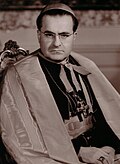 Photograph of the bishop |
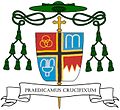 Episcopal coat of arms |
| 86 | Josef Stangl | 1957 | 1979 | * March 12, 1907 in Kronach, ordained a priest on March 16, 1930, appointed Bishop of Würzburg on June 27, 1957, consecrated. September 12, 1957, em. January 8, 1979; † April 8, 1979. |
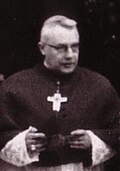 Photograph of the bishop |
 Episcopal coat of arms |
| 87 | Paul-Werner Scheele | 1979 | 2003 | * April 6, 1928 in Olpe, ordained a priest on March 29, 1952 in Paderborn, appointed auxiliary bishop in Paderborn on January 20, 1975 . consecutive March 9, 1975 as titular bishop of Druas , on August 31, 1979 Bishop of Würzburg, em. July 14, 2003; † May 10, 2019. |

|
 Episcopal coat of arms |
| 88 | Friedhelm Hofmann | 2004 | 2017 | * May 12, 1942 in Cologne-Lindenthal, ordained a priest on February 3, 1969 in Cologne, appointed auxiliary bishop in Cologne on July 25, 1992 , ordained titular bishop of Taddua on September 13, 1992, bishop of June 25, 2004 Würzburg, em. 18th September 2017. |
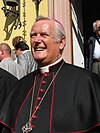 Photograph of the bishop |
 Episcopal coat of arms |
| 89 | Franz Jung | 2018 | * June 4, 1966 in Mannheim, ordained a priest on October 10, 1992 in Rome for the Speyer diocese, elected to the Capitular of Speyer on November 28, 2008 and appointed Vicar General on December 16, 2008, on February 16, 2018 to Bishop of Würzburg called, episcopal ordination on June 10, 2018. |
 Bishop Franz Jung |
 Episcopal coat of arms |
literature
In the Germania Sacra series :
- Alfred Wendehorst : The Diocese of Würzburg 1. The row of bishops until 1254 . (= Germania Sacra; NF 1). Berlin 1962 ( digitized version )
- Alfred Wendehorst: The Diocese of Würzburg 2. The row of bishops from 1254 to 1455 . (= Germania Sacra; NF 4). Berlin 1969, ISBN 978-3-11-001291-0 ( digitized version )
- Alfred Wendehorst: The Diocese of Würzburg 3. The row of bishops from 1455 to 1617 . (= Germania Sacra; NF 13). Berlin / New York 1978 ( digitized version )
- Winfried Romberg: The Diocese of Würzburg 7. The Würzburg bishops from 1617 to 1684 (= Germania Sacra; 3. F. 4). Berlin 2011, ISBN 978-3-11-025183-8 ( review )
Further literature:
- Franz Xaver Himmelstein: Order of the bishops of Würzburg . Second improved and completed edition, prefaced by the most blessed Bishop Georg Anton . FX Bucher, Würzburg 1881 ( first edition from 1843 in the Google book search).
- Peter Kolb, Ernst-Günter Krenig (Hrsg.): Lower Franconian history. Wuerzburg 1989.
- Alfred Wendehorst: The Diocese of Würzburg 1803–1957 . Wuerzburg 1965
- Scientific Association for the German Order e. V., Historical Teutonic Order Compaigne in Mergentheim 1760 e. V. (Hrsg.): 1300 years of Würzburg - signs of history, pictures and seals of the bishops of Würzburg . Issue 23. Lauda-Königshofen 2004
Individual evidence
- ↑ a b c d e f g h i j k l m is not counted in the official list of bishops
- ^ Heinz Wießner: The Diocese of Naumburg 1 - The Diocese 2 . In: Max Planck Institute for History (Ed.): Germania Sacra , NF 35,2, The Dioceses of the Church Province of Magdeburg . Berlin / New York 1998, p. 747.
- ^ Alfred Wendehorst: The Diocese of Würzburg 1803-1957 . Würzburg 1965. p. 21.
Web links
Lists of bishops
- Corrected list of the bishops of Würzburg after Heinrich Wagner
- List of bishops on the homepage of the Diocese of Würzburg
- List of bishops at regionalgeschichte.de
- Wurzburg . In: Heinrich August Pierer , Julius Löbe (Hrsg.): Universal Lexicon of the Present and the Past . 4th edition. tape 19 . Altenburg 1865, p. 432-434 ( zeno.org ).
